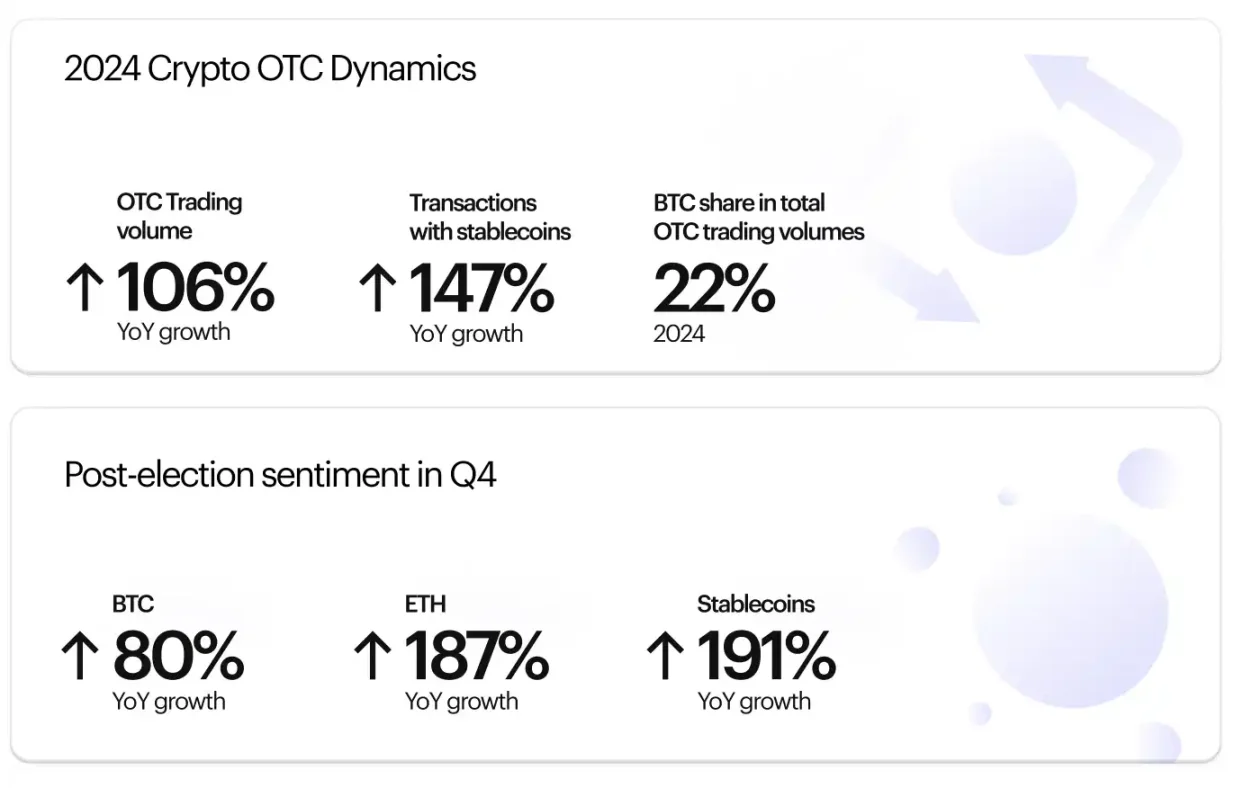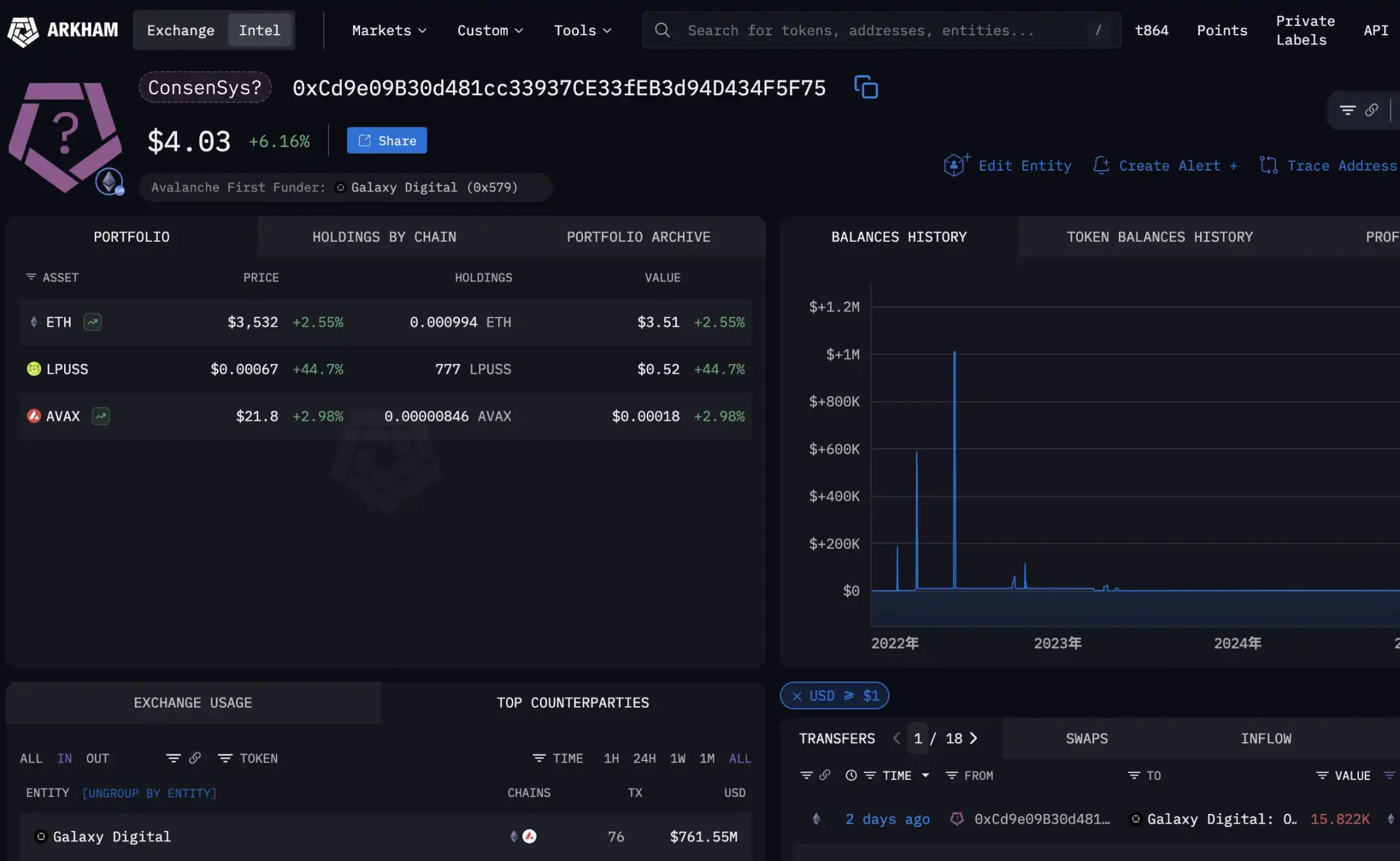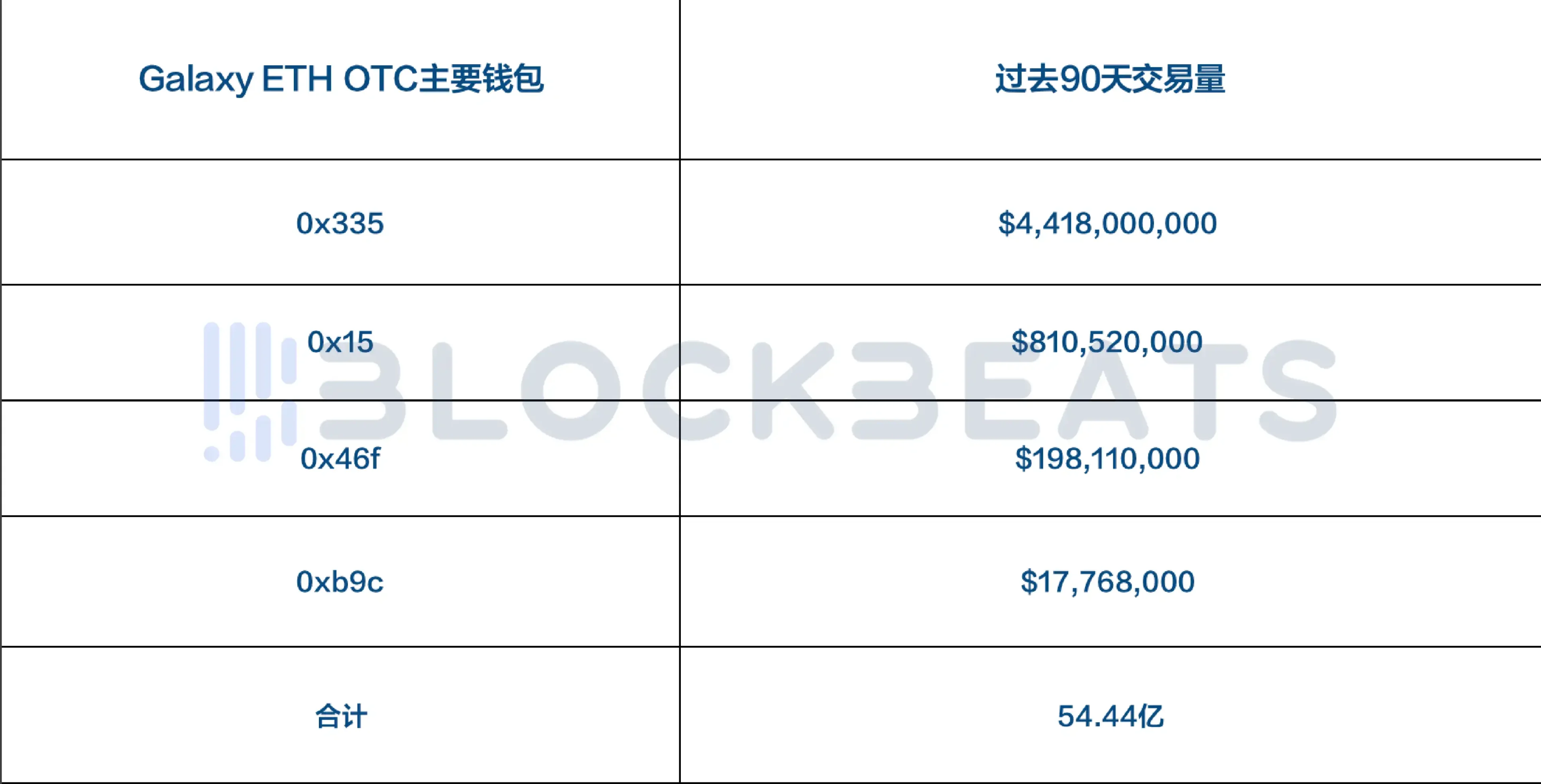Author: BUBBLE
Since the development of crypto OTC platforms, there have been two explosive points: for 2024, the approval of Bitcoin and Ethereum ETFs, while regions like the EU and Dubai have gradually introduced frameworks (MiCA, VARA) allowing OTC trading desks to operate legally on a large scale, as institutions need to rapidly procure underlying assets. By 2025, after former US President Trump proposed the concept of 'crypto capital', traditional finance's overall inclination has turned 360 degrees, and after the introduction of various new crypto policies, Bitcoin hit a new high in early 2025, Ethereum rose strongly, and the institutional asset allocation boom forged explosive growth in OTC platform trading.
Generally speaking, OTC trading matches buyers and sellers directly. They provide single quotes, so there is no slippage or bidding. Transfers are completed through custodial wallets and institutional accounts. Because orders never touch the public limit book, the market will never see your hand cards. As the dark pool of the 'cryptocurrency market', OTC institutions do not publicly disclose the specific trading details of their users, but unlike traditional finance, we can find traces from on-chain queries.
In July 2025, one of the largest Bitcoin OTC trades to date occurred, with 80,000 BTC changing hands for about $9 billion, but the public market remained almost unaffected. The mastermind behind this is Galaxy Digital, the 'most popular crypto OTC institution' on Wall Street today, which also boosted its Q2 revenue by 268 times year-on-year.
What role did OTC platforms play in this wave of compliance? How did Galaxy Digital use its resources to maneuver in coin stock trading? Rhythm BlockBeats conducted a series of studies on this topic.
The third major liquidity pillar in crypto
With this wave of institutional enthusiasm, OTC platforms have become the 'third major liquidity pillar' in the crypto market, alongside centralized exchanges (CEX) and decentralized exchanges (DEX). For large amounts of capital, CEX/DEX cannot directly absorb billion-dollar-level purchases without causing significant fluctuations. Thus, OTC platforms play the role of 'white gloves' for institutions, completing accumulation or liquidation behind the scenes.
Throughout 2024, there was not a single month with OTC trading volume lower than the same period last year, indicating that market participants are increasingly inclined to trade through private channels rather than betting openly in the public market. The crypto industry, in their eyes, has gradually transformed from marginal speculation to an acceptable asset allocation option, with Wall Street shifting from skeptics to participants. This growth is expected to rise exponentially in 2025.
Finery Markets pointed out that an increasing number of traditional financial leaders have shifted from watching to neutral or acceptance, which is a significant reason for the soaring OTC trading volume. As more trades occur in dark pools, the apparent market volatility may be significantly smoothed. According to Finery Markets' report on Q4 2024, it mentioned that the overall trading volume of OTC platforms increased by 106% year-on-year, and the spot volume in the first half of 2025 grew by 112.6% compared to the first half of 2024.

It is worth noting that while compliance environments in Europe and the United States are improving, the Asian OTC market is also on the rise. Licensed OTC platforms in Hong Kong like OSL, as well as emerging platforms in the UAE and Southeast Asia, are attracting global large order liquidity. At the same time, some traditional block trading market makers like Flow Traders are also active, using high-frequency and quantitative strategies to provide bilateral quotes for institutional clients for large crypto trades, improving execution efficiency and reducing impact costs. These factors collectively reinforce OTC's position as the invisible pool of the crypto market.
Galaxy Digital is in the spotlight
Among numerous OTC players, Galaxy Digital, founded by Mike Novogratz, is undoubtedly a star in this wave of institutional buying frenzy. Galaxy is both a well-known crypto investment bank and operates a high-reach over-the-counter trading business, primarily covering trading, investment, asset management, consulting, and mining lines of business. Its clients include top players such as listed companies and hedge funds. However, the main pillar of profit is over-the-counter spot trading and investment. Backed by the founder's 20 years of Wall Street experience and the company's compliance shaping as a public company, more and more institutional funds are flowing in, showcasing astonishing block trading performances on Galaxy's platform, covering mainstream assets like ETH, BTC, and popular coins like SOL, BNB.
Epic 80,000 BTC transaction lands smoothly
As mentioned earlier, the OTC transaction of 80,000 Bitcoins within four days, valued at up to $9 billion, set a record as one of the largest single transactions in crypto history, with Galaxy Digital acting as the intermediary.
Galaxy Digital announced on July 25 that it was commissioned to complete a large BTC sale for an early investor from the 'Satoshi era'. It is said that this was part of the investor's estate planning. Galaxy did not disclose the client's identity but stated that the transaction was a step in a broad wealth management strategy. Surprisingly, the clearing of these 80,000 BTC had almost no impact on the market, starting from July 17 when ancient on-chain addresses began moving, transferring Bitcoin to Galaxy Digital's OTC address within a few days. The clearing of these 80,000 Bitcoins did not reflect in the price of Bitcoin, although a few days later, after Galaxy's news was announced, the price briefly dropped nearly 4% and fell below the $115,000 mark, but within hours the price quickly rebounded to around $117,300.
Analyst Jason Williams pointed out that this massive sell-off has been 'fully absorbed' by the market. Another analyst, Joe Consorti, also remarked that '80,000 Bitcoins (over $9 billion) sold at market price, with BTC prices remaining almost unchanged.' On one hand, this again tests the current market's OTC depth, as there are counterparties who can absorb such a large volume of sell orders shortly after exchange matching. On the other hand, it reflects the importance of 'dark pool trading' in today's cryptocurrency field. In fact, according to the public OTC address (bc1q0), the total value of Bitcoin handled by Galaxy OTC Deck each week reaches hundreds of millions to billions of dollars, and the reality may be even more than this figure.
Preference of ETH coin stock companies
In Q2 2025, multiple unusually large buy orders appeared on the Ethereum chain, attracting close attention from the community. Since July 9, 14 new wallet addresses have cumulatively bought an astonishing 856,554 ETH through OTC platforms like Galaxy Digital or FalconX, valued at approximately $3.16 billion. These wallets had no history on-chain before suddenly receiving large amounts of coins through OTC channels, indicating that 'big players are quietly increasing their ETH holdings.'
On-chain analytics company Arkham Intelligence pointed out that starting from late July, a newly created wallet address (0xdf0A…2EF3) accumulated about $300 million worth of ETH through Galaxy Digital's OTC trading desk within just three days. This address once held 79,461 ETH, costing around $300 million, with a peak paper loss of about $26 million (about an 8.7% drawdown) based on a market value of approximately $282.5 million at that time. This indicates that the giant whale bought at a relatively high average price but is still firmly increasing its position.
Just today, August 5, three new addresses acquired a total of 63,837 ETH through Galaxy and FalconX, worth approximately $236 million. EyeOnChain disclosed some buyer addresses, including 0x55CF…679, 0x8C6b…60, and 0x86F9…446. It is estimated that the cumulative buying power of these addresses reached tens of millions to hundreds of millions, with a single wallet holding over 110,000 ETH at one point (valued over $400 million).
Where is this buying coming from? There are indications pointing to SharpLink Gaming, which has boldly claimed since June 2025 to emulate the MicroStrategy strategy by continuously increasing its holdings of Ethereum as a primary treasury asset. According to its announcements and on-chain data, SharpLink bought nearly 500,000 ETH through ATM financing and OTC trading from the end of June to the end of July, holding 438,190 ETH as of July 27, a 21% increase from a week earlier, with over 77,000 ETH purchased in a single week at an average price of around $3,756.
As of the end of July, SharpLink had accumulated about 449,000 ETH, and into August, the company continued to buy the dip, spending $43.09 million on July 31 to buy 11,259 ETH, and on August 4, it again purchased 18,680 ETH from Galaxy. Analysts claim that SharpLink's total holdings have exceeded 499,000 ETH, with an average cost price of about $3,064, and a current market value of about $1.8 billion, with a floating profit of about $275 million. Such a large-scale purchase of Ethereum was almost entirely completed through OTC counters like Galaxy and FalconX, with even the founder of Wintermute jokingly stating, 'It's almost impossible to buy ETH at our OTC counter now because the whales have already swept away the supply. Besides the current second-largest ETH holder SharpLink, the current largest ETH holder Bitmine is also a deep partner of Galaxy.

The associated address 0xCd9 has transferred over $800 million worth of ETH to SharpLink. $153 million worth of ETH from 0xdf0, $286 million from other addresses are associated with both.
Although we cannot clarify where such a dense accumulation of large OTC positions comes from, this undercurrent is becoming a key force influencing ETH supply and demand. Rhythm BlockBeats roughly calculated that the OTC trading in ETH from several main Galaxy on-chain OTC addresses has reached $5.444 billion in the past 90 days, with an average monthly processing of about $1.8 billion in ETH.

According to Arkham's disclosure of four OTC wallets 0x335, 0x15, 0x46f, and 0xb9c
Acting as both referee and player, the MicroStrategy drama unfolds on the BNB Chain
If BTC and ETH are the protagonists of 2024, then BNB has also stepped onto the stage of institutional layout starting in the second half of 2025. In July, an unexpected news broke: CEA Industrial Company (stock code VAPE), listed on the Nasdaq in the US, announced that it would completely transform into a 'BNB treasury company', planning to raise up to $1.25 billion through private financing and exercising options to purchase BNB. This plan caused VAPE's stock price to soar 550% in a single day.
More notably, the mastermind behind VAPE's recent crypto pivot is David Namdar, co-founder of Galaxy Digital. He will serve as the new CEO of VAPE, while another partner from 10X Capital, former chief investment officer of the California Public Employees' Retirement System (CalPERS) Russell Read, will serve as CIO. Namdar stated that they will actively establish BNB positions using this fund, which is up to $500 million (expandable to $1.25 billion) within the next 24 months, including public market purchases, strategic trades, and earnings through staking and decentralized finance.
This means that BNB will welcome its first large-scale public market institutional buyer, and the OTC channel will undoubtedly play a key role. Due to the high concentration of BNB's issuance and circulation, Binance and its founder Zhao Changpeng CZ reportedly control 71% of the circulating BNB. To absorb hundreds of millions of dollars' worth of BNB without causing significant market fluctuations, they can only turn to over-the-counter block trading or negotiated transfers. Galaxy Digital's rich OTC network and liquidity resources will provide strong support for the 'BNB version of MicroStrategy action' led by Namdar. As the third-largest crypto asset by market capitalization globally, this move marks its formal entry into the institutional asset allocation landscape.
Whether it is Coinbase's integrated trading platform focusing on custody, trading, and on-chain ecology, or the matchmaking of coin stock relations like Galaxy Digital's consulting + OTC trading, or the rapid fusion of traditional brokerages and trading platforms, various sectors in the cryptocurrency field are beginning to move towards compliance and the aggregation of resources towards the top. The recent launch of the Crypto Project may be a significant indication of this trend, as the era of regulatory hegemony for compliant institutions is approaching, and the 'transparent dark pool' of cryptocurrency OTC platforms may occupy an even more important ecological position in the future.



